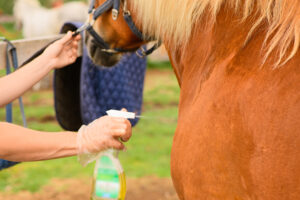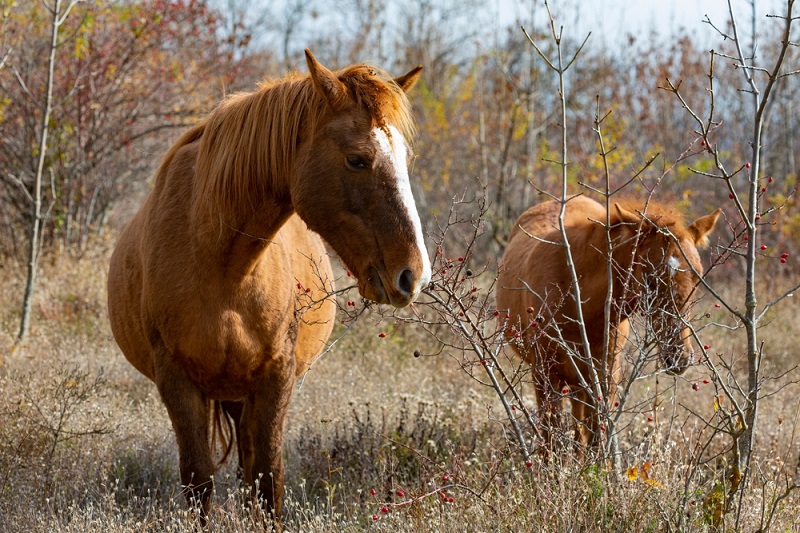What’s no larger than an apple seed, but poses a huge problem for livestock worldwide? That’s right—a tick.
With a single bite, ticks can spread bacteria, parasites, and viruses that develop into serious diseases. When not quickly and properly treated, the results can be fatal for both humans and animals.1 Since horses spend much of their lives outside, they are particularly susceptible to tick bites.
Luckily, there are many ways you can incorporate tick prevention into your daily routine. Just ahead, we’ve created an in-depth guide to help prevent tick bites in horses, remove ticks, reduce disease transmission, and treat tick-borne diseases.
Preventing Tick Bites in Horses
You will never be able to fully remove the threat of ticks and a tick infestation from your environment, but you can reduce the chances of a tick bite. It’s all about being proactive, diligent, and observant. Here are some of the best ways to prevent tick bites in horses.
Strategic Landscaping
As a horse owner, your job is to make your land as uninhabitable to ticks as possible. Also known as “tick-scaping,” this involves routinely mowing tall grass, removing brush and weeds, and clearing away debris. You can also add plots of mulch or wood chips, as ticks don’t like these dry environments. By altering tick-friendly habitats, you can, in turn, reduce their breeding and the chance of a tick infestation.2
Horse Grooming
Cleaning and brushing your horse every day not only helps them look and feel better but also goes a long way toward tick prevention. As you run your hands along your horse, be aware of any small bumps or other irregularities. You will be able to feel an attached tick—allowing you to remove it immediately.
When grooming your horse, pay particular attention to your horse’s mane, tail, underbelly, chest, and ears. Ticks are blind, so they sometimes crawl around a horse’s body to find places where the skin is thinner to more easily feed. These smooth areas are a tick’s paradise.3 (Luckily for us, this makes it easier to find where they might be hiding.)
Insect Repellents
During tick season (spring and fall), spray your field and horses with a tick repellent or fly repellents containing permethrins, which have been shown to be effective against ticks while being non-toxic for animals.4
 Immediate Removal
Immediate Removal
It is crucial to remove an infected tick as soon as you spot it. Ticks do not transmit diseases immediately, so if you catch it in time, your horse may be in the clear. If you do find an attached tick, continue reading for removal instructions.
How to Safely Remove a Tick
After a long ride, you run your hands along your horse’s neck and notice a telltale sign: small, unusual bumps along the skin. You look closer and discover a tick latched onto your horse. What now?
First of all, don’t panic, as that can wind up causing more injury to your horse. Remain calm and follow these steps2:
- Grip the tick with a pair of tweezers.
- Slowly and steadily pull upward, without any twisting or squeezing. You want to avoid breaking off the head or squeezing blood out.
- Kill the tick by dropping it in a jar of rubbing alcohol, flushing it down the toilet, or sealing it in an airtight bag.
- Clean the attachment site with rubbing alcohol or another antiseptic.
- Don’t forget to wash your hands afterward.
Myth Busting
You’ll see lots of antiquated advice about removing ticks, but we’re here to tell you that a lot of that advice can be ignored in favor of the directions explained above.
All of the following are inaccurate instructions on taking care of ticks3:
- Crush or twist the tick – This will only cause the blood inside the tick to eject out onto the horse, which can increase their risk of infection.
- Use baby oil or petroleum jelly – Despite some popular belief, these products don’t have much of an effect on ticks, other than giving it more time to latch on.
- Light a match to burn the tick – Heat is not the most effective in coercing a tick to detach from the horse. It also poses the added risk of burning your horse.
Take our advice: slow and steady tick removal wins the match in this arena.
Tick-Borne Diseases and Warning Signs
Ticks can transmit harmful pathogens at any stage of their life. They can feed for days, during which time they ingest any pathogens carried by the horse they’re attached to, as well as transmit any diseases they were already carrying from a previous host.2
In this way, it is very easy for ticks to transmit infection. Here are some potential tick-borne diseases to watch out for.
Lyme Disease
As the number one tick-borne illness in the United States, Lyme disease is also the most easily transmitted.4 To protect your horses and homestead, it is crucial to be aware of the causes and effects of this tick borne disease.
Through a tick transfer, your horse can also spread Lyme to you and vice versa. That is why the tick prevention measures we mentioned above are so important. Thanks to the innovations of modern medicine, Lyme is not necessarily a fatal disease, and when treated early, your horse can make
a full recovery.
Lyme: Warning Signs
Many symptoms of Lyme could also be the result of other issues like stomach flu, dehydration, or heatstroke, which makes it difficult to determine if your horse actually has Lyme.
No matter what you think the cause is, you should consult with a veterinarian if you notice any of the following clinical signs and symptoms in a potentially infected horse5:
- Inflammation at the bite site
- Lethargy
- Stiffness or lameness
- Swollen joints
- Moody or depressed behavior
- Flinching when touched
- Fever
- Extreme weight loss
Bear in mind that these symptoms can appear anywhere from days to weeks after the initial bite occurs.
Lyme: Treatment and Recovery
If your horse is diagnosed with Lyme Disease, the silver lining is that it can be treated with antibiotics. Both oral and IV treatments are potential options, and you will likely have to contin
ue treatment for about a month to fully eliminate the infection.
The most significant factor of recovery is catching the disease early on. The longer the tick is attached and the infection goes untreated, the worse the prognosis. But when treated early, horses are able to still live long and happy lives.4
Equine Granulocytic Anaplasmosis
This mouthful of a disease, often called just “anaplasmosis,” is transmitted by ticks in the same way as Lyme. Once a horse is infected, the disease targets and destroys white blood cells (granulocytes).
Anaplasmosis: Warning Signs
As with Lyme, it is hard to diagnose anaplasmosis without professional tests. Symptoms of this disease include the following:
- High fever
- Lethargy
- Moody or depressed behavior
- Appetite loss
- Stiffness or lameness
- Swollen legs
Anaplasmosis: Treatment and Recovery
Tetracycline, one of the antibiotics used against Lyme, is also used to treat anaplasmosis. Vet
erinary reports show that symptoms may improve after 24 to 48 hours, after which the horse will continue treatment for seven days.
Reports also show that horses treated for anaplasmosis can develop immunity for up to two years, with no residual symptoms.4
Equine piroplasmosis
Unlike other tick-borne diseases that can be transmitted to both humans and animals, piroplasmosis typically affects horses, donkeys, mules, and zebras. It is a much more fatal condition, with an approximate 50 percent mortality rate.
While the ticks that cause piroplasmosis are not native to the United States, outbreaks have been reported in recent years due to increased globalization. Ticks don’t respect borders—for instance, horses can catch the disease due to land transmission from Mexico or overseas imports from the Caribbean.
Once a horse is infected with piroplasmosis, it becomes a lifelong carrier and can infect other animals. Since this is a blood-borne disease, it can also be spread through medical or dental equipment used on the same horses.6
Piroplasmosis: Warning Signs
Similar to other tick-borne diseases, signs of piroplasmosis can take days or weeks to appear. Here are some common symptoms to look out for6:
- Appetite loss
- Lethargy
- Fever
- Weight loss
- Difficulty breathing
- Swollen abdomen
- Colic
- Sudden death
If horses are not fatally infected, these symptoms typically go away over time with treatment.
Piroplasmosis: Treatment and Recovery
Today, the U.S. Department of Agriculture (USDA) offers official treatment for piroplasmosis. Horses can enter a quarantine within the U.S. to receive care and return to their owners once they test negative.
Protect Your Horses from Ticks with Vetericyn
If your horse is suffering discomfort from a tick bite, check out the topical relief solutions from Vetericyn. While only professional care can treat a tick-borne disease, these sprays and gels can soothe the attachment site in the meantime.
Clean tick bites with our Equine Wound and Skin Care Liquid, designed to sanitize open wounds in horses help prevent infection. Follow it up with the Antimicrobial Hydrogel, designed to lend a soothing cooling sensation while protecting the area. Similarly, our advanced Hot Spot Hydrogel is formulated to accelerate healing from horse rashes, sores, and burns.
Stock up your tack room at a local animal supply store today, or order Vetericyn online from major retailers like Amazon and Tractor Supply.
 Reviewed by Solomon Benarroch, Veterinarian
Reviewed by Solomon Benarroch, Veterinarian
Solomon Benarroch DVM has been a practicing veterinarian for over 30 years. His primary focus has been in equine soundness and performance sports medicine. Originally from Winnipeg, Canada he attended college at the Western College of Veterinarian Medicine. And completed an internship at the University of Minnesota. He is the father of three kids and when he isn’t working (which is rare), he enjoys traveling, cooking, and spending time with friends and family.
Sources:
- Alaska Department of Environmental Conservation. Tick Identification. https://dec.alaska.gov/eh/vet/ticks/tick-identification/
- CDC. Ticks. https://www.cdc.gov/ticks/index.html
- American Association of Equine Practitioners. Tick Control in Horses. https://aaep.org/horsehealth/tick-control-horses
- Practical Horseman. Tick Trouble. https://practicalhorsemanmag.com/health/tick-trouble/
- American Quarter Horse Association. Lyme Disease in Horses: Symptoms, Treatment and Prevention. https://www.aqha.com/-/lyme-disease
- Animal and Plant Health Inspection Service. Equine Piroplasmosis. https://www.aphis.usda.gov/livestock-poultry-disease/equine/piroplasmosis
